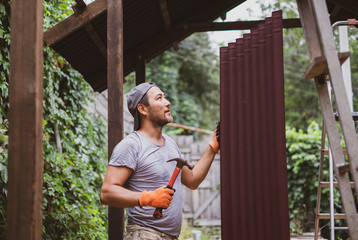A traditional pergola construction process begins with digging a hole two feet deep and nine inches wide. Then, use a reciprocating saw to cut two x 10 beams into thin rafters and affix them to the girders. After the concrete has dried, remove the braces. If your pergola will sit over a stone surface, install metal post anchors. Next, install crossbeams and rafters and finish by attaching them to the top beams.
 If you are not comfortable working with wood, you can always hire a professional builder to build a pergola for you. A professional will use only the best wood and attention to detail to ensure it will stand the test of time. If you’re not sure how to start, you can also refer to websites, which provides detailed instructions for both freestanding and hurricane-resistant pergolas. In addition, these websites include step-by-step plans to guide you through the construction process.
If you are not comfortable working with wood, you can always hire a professional builder to build a pergola for you. A professional will use only the best wood and attention to detail to ensure it will stand the test of time. If you’re not sure how to start, you can also refer to websites, which provides detailed instructions for both freestanding and hurricane-resistant pergolas. In addition, these websites include step-by-step plans to guide you through the construction process.
Once you’ve purchased the materials needed, it’s time to plan the pergola construction. You will need to mark the posts to determine the amount of space you need for each beam. Then, measure each post so that it rests on both crossbeams. Remember to allow a foot overhang on both sides of the posts. Then, cut the crossbeams according to these measurements. You can also use angled rafters if you want to add extra height to your pergola.
Make sure you choose a flat and level area to install your pergola. If you can’t find a level surface, grade the area and save the soil for another use. Remember that the overhangs of the pergola are approximately 18-20 inches past the support posts, so consider this when building your pergola. Before digging, contact your local utility company to ensure there are no underground utilities. The ground is usually a bit uneven, so make sure to grade it to account for it.
Next, you should get a permit and check your local laws to see if you need a permit. Pergolas are freestanding structures, so you may not need a permit if you’re building it on a vacant lot or a very small space. However, if you’re building a large pergola on a property that already has zoning requirements, you may need to obtain a permit.
You can look for a professional who specializes in pergola construction on sites like Houzz. You can also find reviews and photos of past projects to see what they’re like. Ultimately, you’ll find the pergola construction provider who’s right for your home. It’s worth the time and effort to check the requirements of your municipality so that your project can proceed without any legal pitfalls. Make sure to check with your city’s building department before you start the project.
Pergolas are an excellent way to upgrade your home’s exterior while adding privacy and shelter. A closed-roof pergola will provide full shade while an open-roofed pergola will offer only partial shade. Other styles include lattices or slats to keep the sun from getting inside. Whatever design you choose, the pergola should match the look of your house and landscape. Once the structure is up, you’ll need to install the roof, but before you start the project, make sure your beams are strong enough to support the entire pergola.
If you’re on a budget, you can build a pergola using pressure-treated pine. Pressure-treated pine is the cheapest option and is very durable, but it’s also hard to hide its appearance. To make it look aesthetically pleasing, you can stain or paint the pergola if you’d like. Another popular choice is cedar wood, which is naturally insect-resistant and will last a long time.
Whether you choose a pergola kit or design from a manual, you’ll need several essential tools. Then, you’ll need a hammer, screwdriver, tape measure, and a carpenter’s level. In addition to this, you’ll need a wheelbarrow, ladders, post-hole diggers, and mixing trowels. Lastly, you’ll need to wear appropriate protective equipment to protect your skin and eyes.
A pergola adds a unique architectural element to a yard. It’s a great way to accent an existing landscape. A pergola is typically eight feet or higher, and its roof is open, either made of beams and rafters or covered with lattice. In addition to this, a pergola is a great place to grow climbing plants. Whether you choose a pergola to enhance your backyard or make it a more entertaining space, there’s a pergola to suit your needs.
Deep Foundations 2015
How To Construction